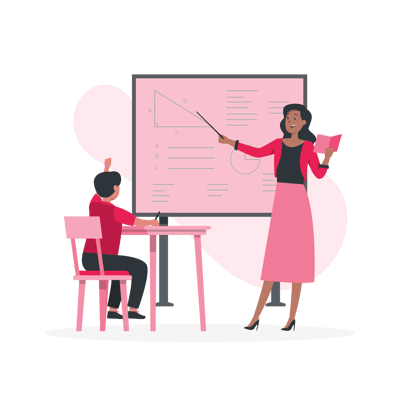Formal Observation #1

Formal Observation #1: Effective Classroom Environment, Instructional Strategies, and Assessments
Kamille Delgardo
Department of Education, CSU Chico
EDTE 255: Introduction to Democratic Perspectives in K-12 Teaching
Lindsey Serrao
October 9, 2024
- How did your ideas on this topic (Effective Classroom Environment) compare to what you observed?
I do not remember desk groups in most of my secondary public schooling but none of the classrooms I’ve observed so far had what I’d consider “traditional” columns and rows of desks. I wonder if that is a recent trend or just coincidental in the videos I chose. Regardless, I think that the layout lends itself to effective classroom management because the arrangement is conducive to group work. Kids are restless and can easily get bored with direct instruction and no collaboration in rows and columns of desks.
On the other hand, the wrong group composition can easily lead a group off the rails. The teacher herself in the air pressure science experiment acknowledged that some groups spent too much time on dead ends when constructing their experiments. In a small group, collaborative environment there is only one teacher to go around to each group and make sure they’re on task and on the right track. I don’t think every lesson necessarily calls for group work, and solo learners also deserve to have activities that they can do alone.
- What did you learn about effective classroom environments and effective instructional strategies and assessment through this observation?
In the primary school lesson about earthquakes there were a number of things I learned with regard to effective instructional strategies. The teacher used multiple modalities to help teach the physical processes that happen during an earthquake, and they didn’t have to be fancy or elaborate to be effective. She used:
- An elastic band to visually explain stress
- Some reading, vocabulary, and individual journal writing to develop language arts
- Scaffolding responses to include emergent bilinguals
- Social media video of an earthquake in action to tie together all the concepts
With regard to Assessment I saw effective summative assessment in the SPED classroom when the teacher was bringing together the entire class for a mock restaurant service experience after spending weeks training serving skills, bringing in guest waiter speakers, teaching about restaurant processes, and connecting her student with job shadow opportunities. I saw formative assessment in a number of the science lessons when teachers would ask students pointed questions in the midst of experimenting to get them thinking about the physical processes occurring. I am learning that assessment doesn’t have to be quizzes and tests, which is what my overall school experience has been based around.
- Consider strategies used to maintain effective classroom environments. Based on your prior experience and the videos you have watched, compare and contrast the strategies observed in these settings.
In all classroom environments I observed copious positive reinforcement to encourage students to contribute. There was a predictable amount of routine (journaling, notes, getting into and out of groups) with enough movement and collaboration to keep things fresh for the students.
An area where I noticed different strategies at play was in managing group dynamics. In the lesson with primary schoolers and building ramps, the teacher decided group composition and made sure for all three experiments each student had a chance to perform each role, making it democratic and fair. In the high school pressure/volume experiment the teacher allowed groups to self-select, then when she cycled the room I didn’t see her making sure every student could answer for what the group was doing. I think this second strategy runs the risk of letting higher-performing group members “carry” the less high-performing while not making sure that everyone is grasping the lesson material.
In one classroom the teacher used popsicle sticks to pull names and get quieter students to answer questions. In the same classroom where there were clearly some high performers, she repeatedly called on these students at other times when they had their hands raised every time. It seems to be a delicate balance of including everyone while making sure that the kids with hands raised don’t feel ignored.
- What ideas pertaining to these topics will you take with you?
I will definitely retain how dynamic all these classes seemed to be. I don’t know if I’m misremembering, but other than science experiments I mostly remember my K-12 classes to be rows of desks, taking notes, and direct instruction the majority of the time. It seems like more work, but I think it can be way more engaging for kids to collaborate with their peers when appropriate. I also appreciated the lessons that incorporated multiple modalities (UDL) to get a fuller picture of the concepts being taught.
I was not in classes with English Language Learners for the latter part of my schooling so I am also very receptive to the strategies I’ve been learning about how to keep them included. These strategies include scaffolding responses (so they can use their own words when possible), utilizing word banks to increase vocabulary, and lots of positive reinforcement. These observations are dovetailing very well with what I’m learning about this unique student population in ENGL 471 (Intensive Theory and Practice of Second Language Acquisition).
- What would you do differently in your own classroom? How and why?
While I appreciate the collaboration, group work, and open-ended discussion-type lessons I observed, I would be more inclined to give more direct help when it’s appropriate and when it’s clear that students are struggling. In some of the experiments I observed it was clear that there were some students with less engagement, participation, and understanding. I think they could have benefitted from direction while letting the average and high achieving students muddle their way through. There is only so much time in a lesson or a day, and I don’t think it serves every student to stick to higher pedagogical ideals or Socratic dialogue in every instance.
